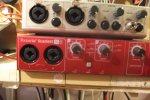I just tested the phantom power with a multimeter, and there's nothing wrong with voltage or current, and nothing wrong with the mic cable. So I guess that leaves me with two possibilities, either faulty mic pres, or a faulty mic. However, the signal that does come through sounds totally fine, just very weak. When I gain it up in Logic there are no weird artefacts, the TLM 102 sounds really good actually. But it still bothers me that I have to turn the gain up to about 90% to get a "useable" signal. If I have the gain at 50% and speak in a normal speaking voice 15cm in front of the capsule it peaks at -41. I have already written to Focusrite support, but while I'm waiting to hear back from them, what would be the next logical troubleshooting test? To try the mic with a different audio interface? To try a different condenser mic in the Clarett?
Edit: I have the thunderbolt version of the Clarett 2Pre.
Just try another microphone. Does not have to be a capacitor, any dynamic should give an acceptable level with speech at 50mm with just about any modern interface.
Dave.



